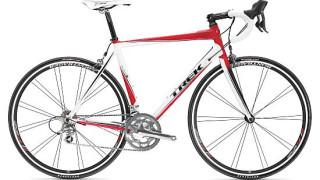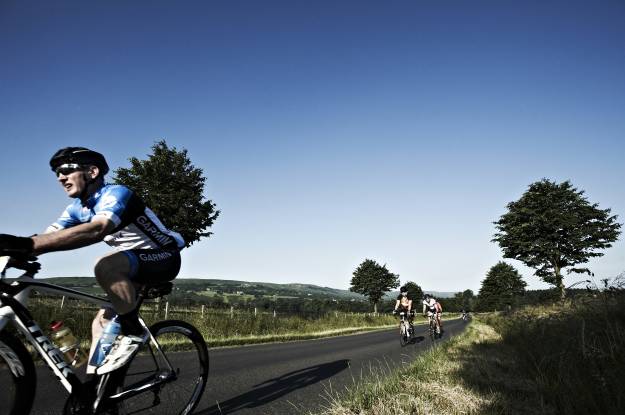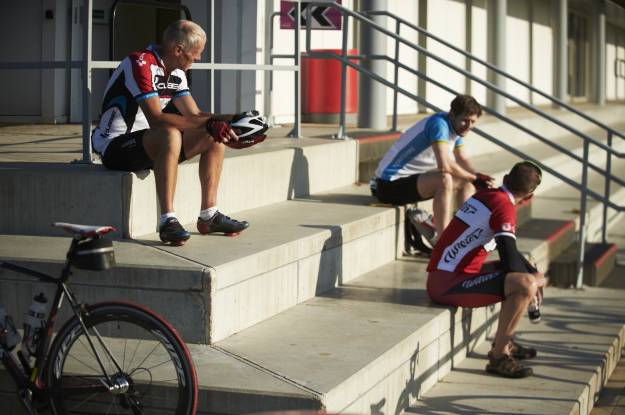Sportive: The Bike
Sportive riding has its own particular set of demands on the bike and the rider. On the surface, you might think that a standard road bike would suffice. And many people (especially regular racers) ride sportives on such bikes. But if you're not a racer at the top of your game, you might consider honing your bike to suit your fitness, the terrain and the level of discomfort you're willing to endure.
The first thing to say is that there are no hard and fast rules on what bike to use for a sportive. Some riders choose a standard road bike for lightness and responsiveness. Others use a fast tourer or ‘audax' bike, which offer a little more comfort and the ability to take mudguards and a rack, with a small weight penalty. Others go for a full touring bike, with greater comfort and lower gearing, albeit with a bigger weight penalty. I've ridden sportives and been passed by people on tandems, converted MTBs and even fixed wheel road bikes, so the options are many and varied (it has to be said that I am pretty slow though!).
What we'll do is look at the main four options of road bike, audax bike, tourer and converted mountain bike, weighing up the advantages and disadvantages of each machine, and also look at what you can do to make each type of bike more fit for purpose.
Road Bike
Above: A lightweight road bike like this Trek with its compact chainset is ideal if all-out speed is your primary goal.
Weighing in at anything from around 15 - 22 lbs, road bikes are light and agile, with frame geometry that gives a responsive and entertaining ride (some more than others). However, the standard gearing on a road bike tends to be a 53/39 double front chainring, combined with a 12-25 rear cassette, giving gear ratios between 41" and 116". This is fine for ultra-fit racers and flatter courses, but an average enthusiast level rider would struggle with a 41" bottom gear on many of the hills used on UK sportives. In the past few years manufacturers have responded with road triple chainsets with 52/42/32 tooth combinations, giving a low gear of 33" - much better for cranking your way up a Lakeland pass. There are also ‘compact' double chainsets with 48/36 or 50/34 chainring combinations which also give much more realistic gearing for average Joes and Joannes.
Standard road bikes will tend to have 23mm tyres, which are fine for short blasts on smooth roads, but some riders can find them punishing on longer rides on rougher country lanes found in many sportives. If you can do so safely, try a 25mm tyre. You might think that an extra 2mm width won't make much difference, but the width makes a significant difference to tyre volume and therefore ride quality. Well worth a try if you're suffering with sore wrists and backside toward the end of your ride. And trust me, it won't make you any slower. In fact, the reduction in fatigue over a long distance may actually make you ‘real-world' quicker.
Standard road bikes also tend to have handlebars set very low, allowing riders to achieve a flat-backed racing position. Although we all like to think we can ape our Tour de France heroes, the fact is that the majority of us haven't got the necessary suppleness to be comfortable or efficient in a flat backed position for too long. Also, racers are racers and therefore accept a certain level of discomfort (usually a high level of discomfort!) as part of the deal. However, you must remember that riding a sportive is meant to be enjoyable, so there's no harm in raising your handlebars to make the reach to the drops a little more realistic. Modern bikes with Ahead stems are usually pretty restrictive in terms of how much you can raise or lower the stem, so you may need to buy a stem with more ‘rise', move the stem to the top of your spacer stack or flip your existing stem so that it points up rather than down.
Of course, any modifications to your bike should be in line with your ability, the terrain and your aspirations. Setting up a bike always involves a compromise between comfort and efficiency.
Fast Tourer or Audax Bike
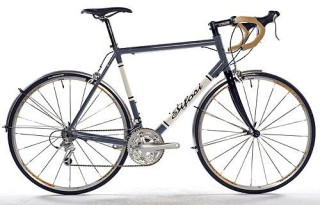
Above: This Tifosi Audax bike cleverly combines comfort and efficiency. Clearance for bigger tyres means greater comfort. Mudguard compatibility means staying dry when the weather turns and the geometry of this bike allows for a higher handlebar position. Also note the triple chainset, giving better gears for the big hills.
Tipping the scales at between 20 and 25lbs, this bike is very similar to a standard road bike, but with the ability to fit wider tyres, mudguards and racks. These bikes were originally conceived to meet the demands of riders in 'Audax' events - endurance challenges where riders must complete a specific course within specific average speed limits (http://www.aukweb.net/). The longest and most famous of these Audaxes (which is French for ‘audacious') is the 1200km Paris-Brest-Paris, where participants ride day and night, battling fatigue, sleep deprivation and everything else that northern France can throw at you.
All of this has resulted in a breed of lightweight, efficient, yet comfortable bikes, which also have the ability to carry light luggage and keep the road spray off your back and out of your teeth. Audax bikes, also known as ‘fast tourers' or ‘winter bikes' also tend to be able to take wider tyres - typically 25-28mm, meaning greater comfort.
If your aspirations favour comfort, whilst not sacrificing too much speed, then the Audax bike could be your best bet - and for sportive riding, they're pretty much perfect straight out of the box.
Tourer
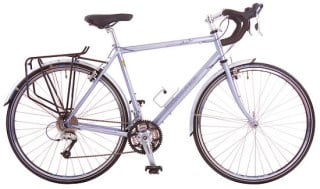
Above: Though not as svelte as an Audax bike, if you've got a tourer like this Dawes, you can still enjoy the sportive experience, although at a more sedate pace.
Already own a touring bike but would like to give sportives a try? There's certainly no need to run out and buy a top end carbon road bike, especially if you're not trying to break any records.
Typically, a steel framed tourer such as a Dawes Galaxy will weight around 27lbs when stripped of its racks and guards and with lighter tyres fitted, which is a significant weight penalty that you'll feel on the hills, especially if the organiser has decided to put in a few nasty stingers at the end of the ride!
However, traditional touring bikes have a lot going for them when put into service in sportives. Drop bars mean multiple hand positions, crucial on a long ride. They've got powerful brakes, essential for long downhills, which are a key feature on most events. They will easily take a 28mm road tyre on standard rims with lots of clearance for mudguards, plus they've got mega-low gearing (in many cases similar to MTB gearing) for the steepest of climbs, which will more than compensate for the weight penalty, if you're willing to sacrifice a little speed.
Lastly, a touring bike will have a longer wheelbase and slightly slacker frame angles, meaning that it will more stable and therefore more relaxing on a long ride. However, if you intend to ride in a bunch, be aware that your bike won't be quite as responsive as those lighter road bikes around you.
Mountain Bike
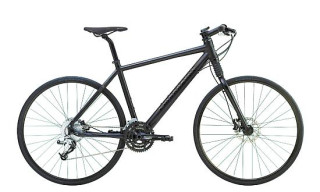
Above: Although Cannondale's Bad Boy Ultra is a billed as a fast urban bike, it is essentially a roadified MTB. It's light with fast-rolling slick tyres, powerful brakes, a lockout fork and gearing that will laugh in the face of Hardknott Pass! Just add a set of bar ends and you're ready.
If you've got a fairly lightweight hardtail MTB, there's no reason why you can't dabble in the sportive scene. Okay, you're not going to win any speed records, but you can still have a great day out, provided you've got the necessary thickness of skin to cope with odd looks from ‘me-too' sportivers and TdF wannabes.
One thing's for sure - you'll have the gearing to get up any hill that a sportive organiser can throw at you. Typically an MTB will have a 42/32/22 chainset teamed with an 11-32 cassette giving you a whopping gear range from a tiny 17" up to 95".
Coming down the other side of the hill, you'll have hydraulic disc brakes to control your speed, and tyres with a greater contact patch than that of a road bike. Team this with the wider bars of an MTB and you've got much more confidence on rough twisty descents.
To ready your MTB for sportive action you'll need to swap-out your knobbly tyres for a lightweight set of slicks - around 1.5 inches wide is a good bet. This will give you far less drag on tarmac, and also much better grip and handling. Squirming around on knobbly tyres on a fast road descent is not fun!
If you've got a suspension fork, make sure you lock it out so you don't lose energy bobbing the fork on the uphills. Better still, consider swapping out the fork for a rigid one - you'll save 2-3lbs in weight and eliminate pedal induced bobbing too.
Make sure that you've got more than one hand position - the standard position on an MTB puts your wrists in a side to side position and forces your elbows out - not good for on-road efficiency. A set of bar ends helps here - allowing you to put your hands in a more natural and efficient ‘fore to aft' position. Some long distance tourists who use MTBs mount bar ends inboard of the brakes and shifters, giving them that fore to aft wrist position with the added benefit of a narrower frontal area - meaning less wind resistance. Others tape the central sections of the handlebar to give them a narrower position for long, smooth flat roads and climbs.
Horses for Courses
It's a cliché for a good reason - because it's true. You decisions will be based on how serious you are about going fast, how much discomfort you're prepared to endure, what the course is like and how deep your pockets are. But don't be put off trying sportives just because you haven't got ‘all the gear'. My first sportive was ridden on a cheap flat barred road bike. I've ridden a 100 mile sportive on an MTB. I've also ridden a few sportives on a proper road bike and to be honest, the results were much the same. Each bike had it's merits.
A few years ago during an event in North Wales, I was passed by former End-to-End record holder Andy Wilkinson, who was riding a roadified Cannondale MTB with slicks and tri-bars. Now there's a guy who knows a thing or two about riding long and riding fast - and a great reminder that you don't have to follow the crowd.
What do you ride?
Tell us what bike you use to tackle sportive riding? Or if you've got any tips on adapting your bike for these long distances events, where balancing comfort and efficiency is key. Post you ideas using the Comments function below, or write your own article in your Profile area.

